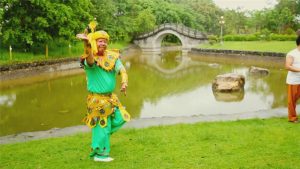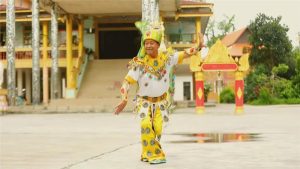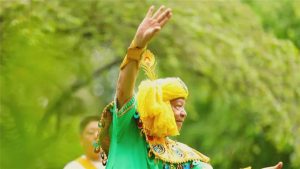 alt="Puer Surrounding Counties and Towns: Weekly & Special Local Markets Travel Guide"
/>
alt="Puer Surrounding Counties and Towns: Weekly & Special Local Markets Travel Guide"
/>
Peacock Dance of Dai Ethnic Minority

The Peacock Dance is the most famous dance in the Dai Minority area – Yunnan Province, China. It spreads in Ruili and Luxi(潞西) of Dehong Dai Jingpo Autonomous Prefecture, Xishuangbanna, Gengma, Menglian, Jinggu, Cangyuan. The peacock dance in Ruili City is the most representative.
The Dai people call the peacock dance Galuoyong(嘎洛勇). The peacock is a symbol of happiness in the history of Dai people. There was a story about the origin of the peacock dance. A thousand years ago, the father figure of Dai Minority saw a beautiful peacock dancing gracefully, and he could not help imitating it. From generation to generation, thousands of folk dancers made the “Peacock Dance” perfect continuously.
History of the Peacock Dance
In Eastern Han Dynasty, Dai people often went to Luoyang (the ancient capital of China/洛阳) to dedicate the “Peacock Dance” to the emperor. It can be inferred that the Peacock Dance had already reached a high level two thousand years ago.

The Importance of Peacock Dance
In Dai people’s heart, peacock is the symbol of beauty, happiness and luck. Whenever there are parties or festivals, Dai people will perform the peacock dance to celebrate.
Content of the Peacock Dance
Peacock dances in different regions have rich national cultural connotations and high artistic appreciation. Ruili’s Peacock Dance is mainly a single dance,but there are also couple dances. Dancers are mostly male. Yuexiang(约相), Wangla(旺腊), Dasanmeng(大散梦) and Hansi(喊思) are the representative of the local peacock dance. There are three forms of performance for peacock dance:
- Singles Peacock Dance: Mainly simulates the posture and movement of the peacock.
- Couple Peacock Dance: One female and one male, cuddling each other, chasing and playing.
- Multi-person peacock dance: Performed by at least four or more dancers.

The Features of the Peacock Dance
- First, the dancers’ knees always wave flexibly. It is the common feature of Dai dance. The knees don’t wave mechanically but flexible according to the change of performers’ sentiment.
- Second, the elegant dance is shown by the flexibility of performers’ arms, wrists, and fingers. The movements are soft and elegant to show the docility of peacocks.
- Third, the performers’ legs move promptly and the eyes move flexibly to show the flexibility of the peacock.
Source from www.ynich.cn/view-ml-11110-1238.html

 7 Days GolfingTour
7 Days GolfingTour
 8 Days Group Tour
8 Days Group Tour
 8 Days Yunnan Tour
8 Days Yunnan Tour
 7 Days Shangri La Hiking
7 Days Shangri La Hiking
 11 Days Yunnan Tour
11 Days Yunnan Tour
 6 Days Yuanyang Terraces
6 Days Yuanyang Terraces
 11 Days Yunnan Tour
11 Days Yunnan Tour
 8 Days South Yunnan
8 Days South Yunnan
 7 Days Tea Tour
7 Days Tea Tour
 8 Days Muslim Tour
8 Days Muslim Tour
 12 Days Self-Driving
12 Days Self-Driving
 4 Days Haba Climbing
4 Days Haba Climbing
 Tiger Leaping Gorge
Tiger Leaping Gorge
 Stone Forest
Stone Forest
 Yunnan-Tibet
Yunnan-Tibet
 Hani Rice Terraces
Hani Rice Terraces
 Kunming
Kunming
 Lijiang
Lijiang
 Shangri-la
Shangri-la
 Dali
Dali
 XishuangBanna
XishuangBanna
 Honghe
Honghe
 Kunming
Kunming
 Lijiang
Lijiang
 Shangri-la
Shangri-la
 Yuanyang Rice Terraces
Yuanyang Rice Terraces
 Nujiang
Nujiang
 XishuangBanna
XishuangBanna
 Spring City Golf
Spring City Golf
 Snow Mountain Golf
Snow Mountain Golf
 Stone Mountain Golf
Stone Mountain Golf













 What Our Customers Say?
What Our Customers Say?
